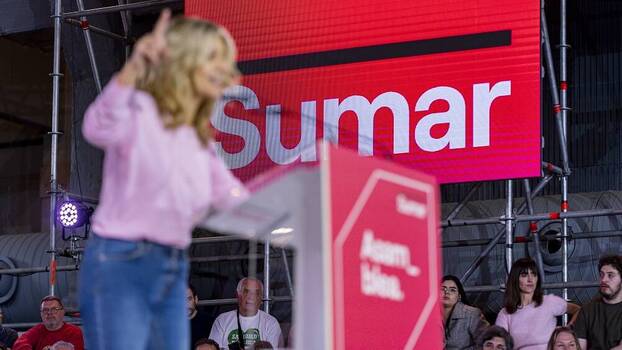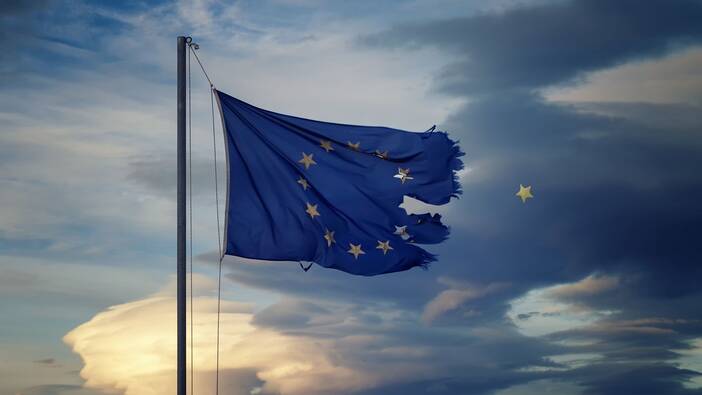
In the Spanish State, all indicators seem to point in the same direction: we are coming to the end of a cycle, in which what has been called the “Space for Change” is in retreat and even disappearing in many regions. Significant internal disagreements within the Left, right-wing and far-right parties committed to propagating fake news and stoking tensions, and a social democracy that has been neglected for years have all come together to create a society divided by media and discursive polarization, and the disaffection of the majority of citizens.
María del Vigo works as a freelance communications consultant at the Rosa Luxemburg Foundation’s Madrid Office.
The emergence of left-wing party Podemos and the city-based “municipalist” initiatives — both part of the “Space for Change”— from 2014 onwards, challenged the two-party system. Ten years later, the trend seems to indicate a return to it, both at the state and regional levels, including areas with pro-independence tensions, where the struggle for power is between a pro-independence Right and a pro-independence Left. Those who had hoped for the emergence of a political entity advocating a plurinational Spain as a solution to the regional tensions have either disappeared or have found themselves politically isolated.
Half of an MEP for the Left?
Since Sumar and Podemos settled their differences with a definitive break-up in the national parliament, three regional elections have been held across the Spanish State: in Galicia, the Basque Country, and Catalonia. The results across these elections have been mixed, with none of them giving much cause for optimism. The European elections on 9 June 9 do not present a very positive scenario for the Spanish Left, either. With the campaigns not yet kicked off and the platforms still to be published, we cannot analyse their contents and promises, but the make-up of the electoral lists and alliances provide some interesting data.
Left-wing electoral alliance Sumar has put forward the director general of the Refugee Aid Commission (CEAR), Estrella Galán, at the head of its electoral list. After strenuous negotiations that seemed to have left everyone unsatisfied, the number two position went to Catalunya en Comú (Jaume Asens), the third place goes to Compromís (Vicent Marzà), Izquierda Unida (IU) holds the fourth position (Manu Pineda), Más Madrid (Andere Nieva) the fifth, and Verdes Equo the seventh (Florent Marcellesi). The latest polls predict Sumar will win between three and four seats, meaning that IU’s spot is not a sure thing.
The coalition that Yolanda Díaz brought together for these elections also includes other regionalist groups, such as the Chunta Aragonesista and the Partido Castellano-Tierra Comunera (PCAS-TC), which won’t win any seats but will bring in some votes.
The variety of political parties within the coalition would also be reflected in the European Parliamentary Groups they would join. Numbers two and three on the list are members of Catalunya en Comú and Compromís, respectively, parties that until now have been integrated into the Greens/European Free Alliance (Greens/EFA). Number four, Manu Pineda, is MEP for The Left in the outgoing parliament. Sumar has not yet stated which parliamentary group Estrella Galán, the head of the list, would join.
In the best-case scenario, taking the poll results which are the most optimistic for the Left, four candidates from the Spanish State would join The Left’s European parliamentary group.
For its part, Podemos, led by former Equality Minister Irene Montero, is running on a joint ticket with Alianza Verde, a breakaway from the green party Equo led by environmentalist Juantxo López de Uralde. Following Montero on their list, in this order, are the current state co-spokespersons of the party, Isabel Serra and Pablo Fernández, and Serigne Mbayé, social activist, Unidas Podemos councillor in the Assembly of Madrid regional parliament between 2021 and 2023, and currently Podemos’s anti-racism secretary. The first spot on the list for Alianza Verde is in seventh place. It is held by Alba Ramos Solano, who appears in the latest official state bulletin as an independent.
Historically, Podemos’s results have exceeded polling expectations, and Montero has a flair for electoral campaigns. However, the current reality is that with just under a month to go before the election, the polls are giving Montero’s group only one seat. In any case, whether they gain one seat or more, the Podemos MEPs will join The Left.
In the best-case scenario, taking the poll results which are the most optimistic for the Left, four candidates from the Spanish State would join The Left’s European parliamentary group: Irene Montero, for Podemos, Estrella Galán and Manu Pineda for Sumar, and Pernando Barrena from Euskal Herria Bildu (EH Bildu). The latter is running as number two in the Ahora Repúblicas (Republics Now) electoral alliance, which brings together Esquerra Republicana de Catalunya (ERC), EH Bildu, the Bloque Nacionalista Galego (BNG), and the Balearic pro-independence party Ara Mes. This coalition, without the Balearic parties, won two seats in previous EU parliaments.
The way it has worked so far has been that the second seat rotated in the middle of the term to give all three parties some representation. On this occasion, the polls give Ahora Repúblicas one more seat, taking them up to three, which would mean an MEP from ERC, one from EH Bildu and a third from BNG. If the polls are right, this system of rotating seats will not be necessary in the next parliament.
At the other extreme, in the worst-case scenario for The Left in the EP, Podemos might not win its seat, Sumar would get three seats, Estrella Galán would also join the Greens/EFA, and Ahora Repúblicas would get two rather than three seats. In this case, Barrena (EH Bildu) would only be there for half of the parliamentary term and would have to resign to make way for the next MEP on their list: Ana Miranda of the BNG, who has been an MEP for the Greens/EFA since September 2022. If that were the case, the Spanish State would just add “half of an MEP” to The Left.
The Left-Right Axis and Regional Tensions
As mentioned above, there have been three regional elections in Spain in recent months. Although these are three Autonomous Communities with enough specific characteristics that their results cannot be transferred to the rest of the Spanish State or the European elections, they do point to a bipartisan trend in two respects.
In Galicia, with an electoral turnout of 67.3 percent, neither Podemos nor Sumar managed to get into power. In the Basque Parliament, the Space for Change was, up to now, represented by Elkarrekin Podemos (UP) with six seats. This time, with a turnout of 62.5 percent, Podemos was left out of parliament, and Sumar won one seat. The pro-independence, left-wing BNG and EH Bildu, meanwhile, achieved a notable increase in votes. The BNG went from 19 to 25 seats and EH Bildu from 21 to 27, with 38 seats being the absolute majority in both cases.
At the moment, the main beneficiary of the Left collapsing like a house of cards is Prime Minister Pedro Sánchez, who seems to have everything working in his favour.
Catalonia was the most recent Autonomous Community with notable tensions around independence to go to the polls. The result there was different for several reasons. Podemos chose not to stand and Sumar, in alliance with the Comunes, won six seats, losing two, with a turnout of 57.9 percent. ERC lost 13 of the 33 seats it had previously held and, along with them, governing control. Now the question is whether there will be a left-wing government bringing together nationalist and non-nationalist parties, or a government that prioritises independence over whether its members are progressive or conservative.
Sánchez Is All Smiles
At the moment, the main beneficiary of the Left collapsing like a house of cards is Prime Minister Pedro Sánchez, who seems to have everything working in his favour.
A few weeks ago, Sánchez took the unprecedented step of publishing a letter to the public in which he announced a five-day retreat for reflection, in which he would decide whether or not to resign as president of the national government. Begoña Gómez, the prime minister’s wife, had been accused of influence peddling by the ultra-right union Manos Limpias.
This was a textbook case of lawfare. Manos Limpias and similar organizations have launched much more vicious attacks on public representatives from the Space for Change. Some of them even sat on the Council of Ministers with Sánchez. The prime minister, however, never defended them as decisively as in this situation.
We will probably never know whether the prime minister was really pondering leaving the government’s Palace of Moncloa, or whether it was a risky marketing strategy. Nevertheless, it seems to have worked. Lawfare and fake news have become the latest hot topics, and the public is now questioning the independence of the judiciary. The PSOE’s results have experienced a surge in the last three regional elections and Sánchez remains the most popular leader according to Spain’s Sociological Research Centre. He has put forward a heavyweight from his government as a candidate for the European elections: the current Third Vice-President and Minister for Green Transition, Teresa Ribera.
The latest polls place the centre-left PSOE second, around six seats behind the main right-wing party Partido Popular (PP), but the PSOE seems intent on closing that gap. For the moment, however, the Right and the far right are expecting to make gains with respect to the 2019 elections. Far-right Vox would go from three to six seats and the PP from 12 to 25. Although part of the increase is due to the de facto disappearance of centre-right Ciudadanos (until now part of the Liberal Group in the European Parliament), which obtained 7 seats in 2017, it is clear that the trend is upwards, as in other EU countries.
The Importance of Participation (or Lack Thereof)
In the 2019 European elections, 60.70 percent of the citizens called to vote in Spain took part in the elections. The average turnout in the last election was 50.66 percent. Germany, for example, ranked third out of the 28: 61.38 percent of those eligible to vote did so.
The Eurobarometer forecast for Spain is for a turnout of 64 percent on 9 June, and points to the international crisis as a mobilizing factor. At any rate, the figure is surprising considering that in 2019, the European elections in Spain coincided with municipal elections and, in 12 of the Spanish State's 17 regions, also with regional elections, which can be seen as a factor increasing the voter turnout also for the EU elections. In the previous 2014 call to the polls, only for European elections, the turnout was 43.81 percent.
It was in the 2014 European elections that Podemos ran for the first time and won five seats. The coalition which included Izquierda Unida won six. Each seat then cost about 250,000 votes. In 2019, 375,000 were needed to get a representative into the European Parliament. The final voter turnout, therefore, will determine whether the polls we have been analysing will prove to have been optimistic or pessimistic.
